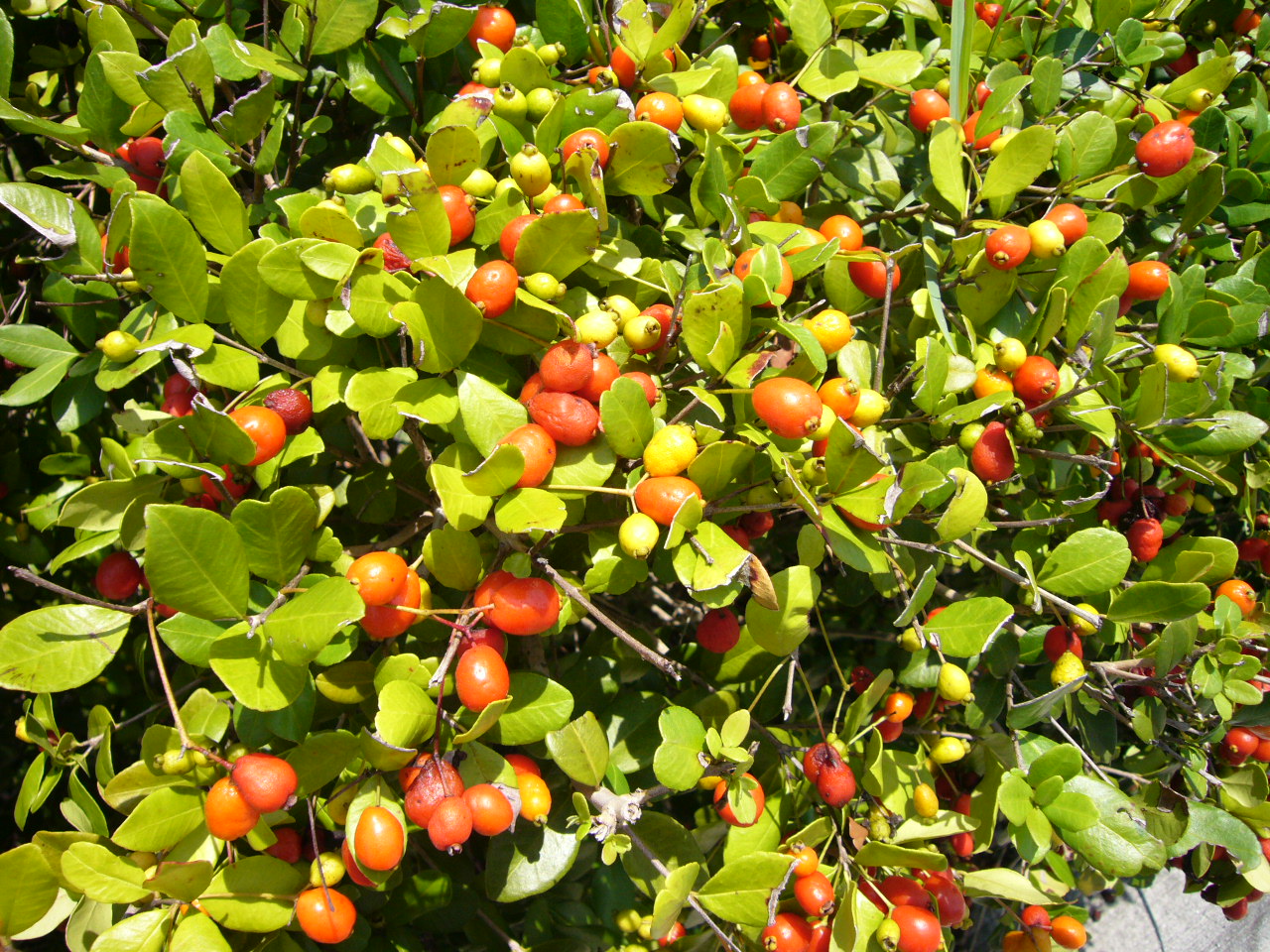
Twin Berries are beginning to ripe. Photo by Green Deane
If you study nature you soon learn seasons vary and plants respond. This year chanterelles are missing in some locations, some podocarpus are a month early, single-tendril grapes are pushing the season, and wild garlic withered early.
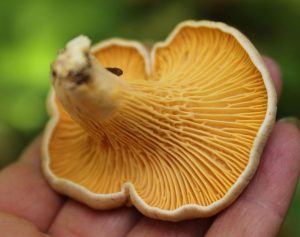
Chanterelles have cross wrinkles.
The reluctance of chanterelles to flush is caused by lack of rain in a given area, the other requirement, besides the preferred trees, is warm overnight temperatures — why morels don’t grow in Florida. Plants have requirements regardless of what we think of them. My mushroom mile, a favored location where I harvest many different species, is still empty of them including the usual toxic ones.
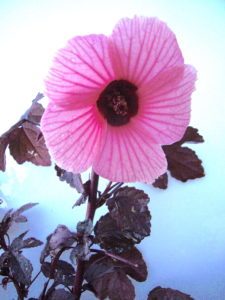
The blossom and leaves are edible on the False Roselle. Photo by Green Deane
A species responding to thehopefully wetter weather is the False Roselle. It grows “wild” in my back yard. I noticed this past week seedlings coming up. To the eyes of anyone who looked at plants in a northern climate ones first guess on seeing the False Roselle is that it is a misplaced Red Maple. The resemblance is superficial but close enough to give one pause. Though I would not label the tree with a Pampered Chef epitaph but to me the leaves say “Salads and Stir Frys. Its purple leaves — true purple, not the reddish green of the true Roselle — are tart and just rightly so. They go into salads well. More so, they take to quick vegetable-lush stir fries and do not lose their color or taste on cooking. It’s even a good tree to nibble on wherever you find it. The species, interestingly, is not long-lived, a few years at best like Elderberry. But it spreads easily and can be grown from seeds or better from shoots. Just cut off a few young branches, take off the lower leaves, put the stems in water and within a couple of weeks you will have well-rooted twigs to plant. In fact I over-winter some every year. A heavy frost or a light freeze will die them back to the roots. Young trees will come back in the spring, but often older plants won’t. So I raise a few in the winter to make sure I can restock in the summer. The blossoms are edible as well and a juice can be made from the caylexs. Red Maple are more iffy. Red Maple leaves are bitter but humans can eat a few of them. However, Red Maple leaves are deadly to horses and they will eat them. Keep your horses away from Red Maples. You can read about the False Roselle here
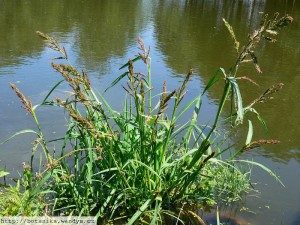
Barnyard grass can be used like wheat
One would think that with a name like “Barnyard Grass” one would find it in barnyards. But no. It is probably safe to say you will rarely find Barnyard Grass in a barnyard. Why? Because Barnyard Grass likes to grow in water, lots of water. You can easily find it in ponds, streams and drainage ditches but not barnyards unless it is growing directly under the roof drain spout in a very low, wet spot. In all my years of foraging I have seen Barnyard Grass once in a barnyard but dozens of times in water. In wet areas look for a tall grass that resembles wheat. The stems will be hairy and usually purple at the base. One easy place to find them locally is in dried up lakes. Often at the still-damp low spot Barnyard Grass will colonize the entire low spot. Not a native it comes in season at the same time and one can find it seeding now. The grain is a bit more coarse than wheat but can be harvested, prepared and used the same way. You can read about Barnyard Grass here.
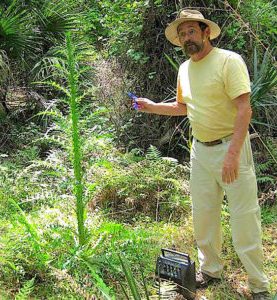
Foraging classes are held rain or shine, heat or cold. Photo by Nermina Krenata
Shall we sneek in a couple of classes before we get a parade of tropical storms?
July 22nd, Colby-Alderman Park: 1099 Massachusetts Street, Cassadaga. Fla. 32706. 9 a.m. Meet at the bathrooms.
July 23rd, Wickham Park: 2500 Parkway Drive, Melbourne, 9 a.m., meet at the dog park.
For more information, to pre-pay or sign up for a class go here.
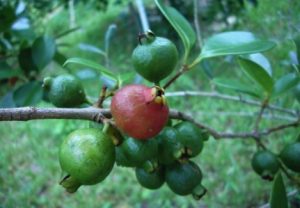
You want pink and green strawberry guava. Photo by Green Deane
Nearing the end of its fruiting season is a species that is very invasive in some areas: The Strawberry Guava. Invasive in Hawaii, I had a Strawberry Guava in my yard for about 15 years. Not only are the fruit edible but the dried leaves can be made into a passable tea. One does, however, need to know a little about the species to make the most of the fruit. It’s a little smaller than a ping-pong ball, has tough seeds, and starts out green and hard. As it ripens and softens it will get shades of pink, yellow and red and eventually become dark red and soft, hence the name “Strawberry Guava.” The fruit is tart and sweet, more tart when young, more sweet when older. Despite the name I never tasted a strawberry flavor in any of the fruit. The problem is unless you spray the tree with insecticides the ripe fruit will be full of fly larvae (which you can also view as free protein.) When the fruit is just starting to turn from green to red the rind is too hard for the flies to lay eggs through. But by the time they are soft and ripe they are prime breeding ground. Thus you have a choice, slightly ripe and tart but bug free, or, very ripe and sweet and squirming. To read more about the Strawberry Guava go here.

You get the USB, not the key.
150-video USB would be a good end of spring present and is now $99. My nine-DVD set of 135 videos has been phased out. The USB videos are the same videos I have on You Tube. Some people like to have their own copy. The USB videos have to be copied to your computer to play. If you want to order the USB go to the DVD/USB order button on the top right of this page. That will take you to an order form. I’d like to thank all of you who ordered the DVD set over the years which required me to burn over 5,000 DVDs individually.

Green Deane Forum
Want to identify a plant? Perhaps you’re looking for a foraging reference? You might have a UFO, an Unidentified Flowering Object, you want identified. On the Green Deane Forum we — including Green Deane and others from around the world — chat about foraging all year. And it’s not just about warm-weather plants or just North American flora. Many nations share common weeds so there’s a lot to talk. There’s also more than weeds. The reference section has information for foraging around the world. There are also articles on food preservation, and forgotten skills from making bows to fermenting food.
This is weekly newsletter #566. If you want to subscribe to this free newsletter you can find the sign-up form in the menu at the top of the page.
To donate to the Green Deane Newsletter click here.

